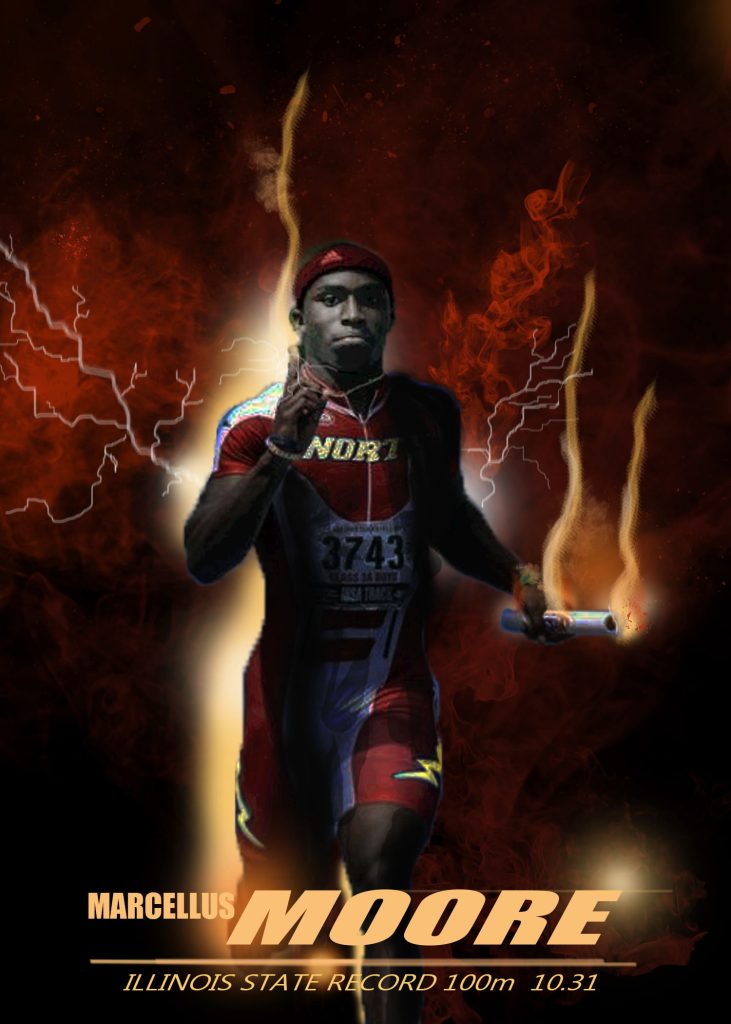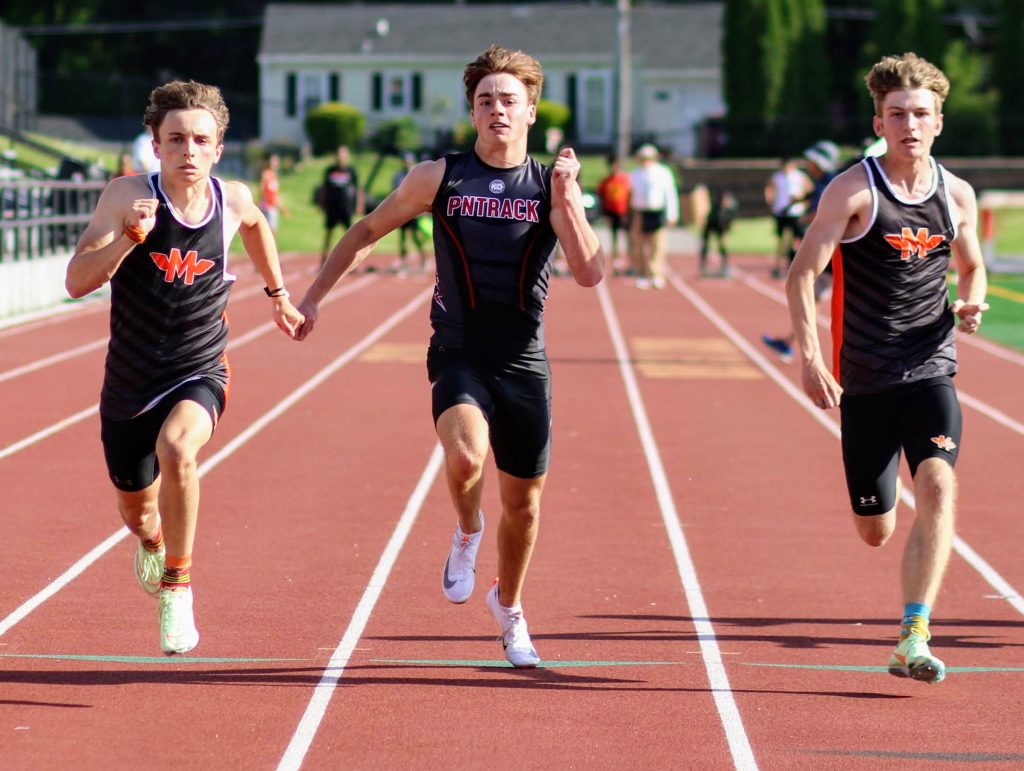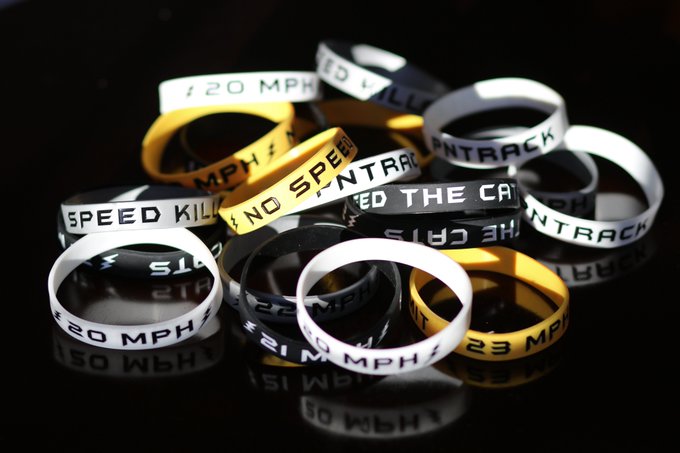Translating MPH Into Track Times
If you run ____ mph how fast can you run the 100 meters? 200 meters? 400 meters?
I get this question a lot.
At the risk of sounding like Stu McMillan (“It depends”), it depends on that athlete’s ability to MAINTAIN a high speed.
Marcellus Moore in the winter of 2017-18 ran an average best 10m fly time of 0.98 (22.8 mph) and his best time was 0.93 (24.1 mph). In the winter of 2018-19, Marcellus ran an average best daily time in the 10m fly of 0.95 (23.6 mph). His best time was, again, 0.93 (24.1 mph).
Since Marcellus was capable of running 24.1 mph (10.77 m/sec), he was capable of running a 9.28 100m fly.
Track coaches understand that a fly has a “flying start”. In other words, you are not starting off at zero mph. The best example of this is the difference between a relay split and an open race. The difference between a relay 4×1 split and a 100m time is typically around one second. The same applies to relay splits in the 4×2 compared to the open 200. 4×4 and 400, same again, one second difference.
Marcellus is an interesting case. On three different occasions, we timed Marcellus at 9.3 anchoring the 4×1. The math of mph to fly times held true. Based on the ability to run 24.1 mph, Marcellus had the potential to run 9.28.
How about Marcellus in the open 100 meters? Well, if you add one second to 9.28, Marcellus would have a ceiling in the 100m of 10.28. He ran 10.31 for the IHSA All-Time Record. That’s 99.7% efficiency.

Notice that I used the word “ceiling” in the previous sentence. You can’t run races at speeds you can’t achieve. Profound huh? In other words, the thing that kept Marcellus from breaking 10.00 was the fact he could “only” run 24.1 mph. To break 10.00, Marcellus would have to raise his ceiling to 26 mph. Usain Bolt’s world record 9.58 included a 10m split where he hit 27.6 mph.
Many sprint coaches focus their attention on acceleration because they are not patient enough to focus on improving max speed (speed grows like a tree). Others see acceleration as a coached trait while maximum velocity is a purely genetic. Not me. I see acceleration and top speed as interrelated, both electrical, both driven by the CNS. Get faster, acceleration improves. Speed is the tide that lifts all boats. Slow guys don’t accelerate very well.
Marcellus Moore was phenomenal at MAINTAINING his top speed. He was the best I’ve ever seen. Fantastic efficiency. No leakage. You could coach in five decades, like me, and never see anyone who could stay so close to his ceiling for 100 meters (99.7%).
CEILINGS
The ability or inability to maintain speed is fascinating. It’s structural, mechanical, biochemical, and CNS-driven. In the 100m, maintaining top speed has nothing to do with endurance. In other words, running cross country will not allow you to maintain 24 mph for ten seconds. (In my experience, the fastest cross country runners top out at 21 mph).
MPH is the ceiling of a sprinter. But, mph can’t project a sprinter’s time in the 100m
Dylan Gramley was my top sprinter this year. In 2019, Dylan was a good freshman, 4th fastest freshman in his class. Dylan Gramley’s best 10m fly time in the winter of 2019 was a 1.06, 21.1 mph, 9.43 m/sec. That would indicate a fly 100m ceiling of 10.60, open 100m ceiling of 11.60. Dylan ran the 100m four times in 2019, averaging 12.01. Efficiency = 96.6%. Just because Dylan’s 2019 ceiling was 11.60 in the 100m, that doesn’t mean he was capable of running 11.60. My young sprinters can’t come close to their ceiling in the 100m.
Fast forward to Dylan’s senior year. Dylan’s winter best 10m fly time was 0.99, 22.6 mph, 10.10 m/sec. That would indicate a 100m ceiling of 10.90. On April 9th at Belleville West, Dylan ran 10.82. Two weeks later at Edwardsville, Dylan ran 10.71. At Sectional, Dylan ran 10.73. Wait! I thought his ceiling was 10.90? I thought no one is capable of running at speeds faster than they ever achieved. Maybe the difference maker was wind. We have no wind in our field house. Like all 100m races these days, Dylan ran with the wind. Dylan ran those 100m times with wind at his back.
I have a theory that the best sprinters might find slightly higher max velocities or hold their top speed better in the fire of competition. For these elite athletes, competition is a performance enhancer. For most kids, the anxiety of competition distracts them. Their brain is cluttered and performance suffers.

Picture above: This unlikely trio ran 10.63 (Tyler Colwell), 10.73 (Dylan Gramley), and 10.71 (Cael Hiser) at the Rock Island Sectional in May. Colwell ran 10.48 as a junior and will attend Colorado State.
There’s also the murkiness of practice times. Dylan may have run 22.6 mph as his best indoor 10m time, but he’s hit 23.5 mph in the 10m fly outdoors (wind?). He also hit 23.5 mph indoors in the 10-yard fly. To confuse matters further, Dylan oddly ranked 4th on our team in the 20y competition fly, running only 22.5 mph.
Now that your head is swimming with numbers after re-reading the last three paragraphs multiple times, let’s simplify.
Dylan Gramley is fast. That’s pretty simple, huh? Dylan loves training and loves competing. He wears a 23 mph wristband. That’s fast enough so go sub-11 and sub-11 is Illinois-fast. (Those dopamine-saturated sprinters in the sunshine states would not run the same times in cloudy cold states up north.) The fact that Dylan can run so close to his ceiling has a lot to do with the above-mentioned structural, mechanical, biochemical, and CNS-driven factors. It also might have something to do with the amount of time that we spend sprinting. We don’t run laps, don’t run tempo, no warmups, and no cool downs. We are what we do and at Plainfield North, our cats sprint.
This sounds bizarre as hell, but most track teams spend zero time at max velocity. They run but don’t sprint. In a typical week, my guys will get to maximum speed about six times for just a couple seconds each. How can coaches believe that sub-max running (never sprinting) will result in a sprinter being able to maintain his max speed, never practiced, for 100m? I call this planting beans to grow corn. Maybe these coaches have been influenced by Stu McMillan, who bragged in 2016 that Andre De Grasse won silver in Rio without ever training at max speed. “For those who think you must sprint maximally to get faster, not once all year did De Grasse sprint at maximal speed.” ~Stuart McMillan
If you want to read more about my thoughts on sub-maximal training… ANDRE DE GRASSE, STUART MCMILLAN, AND SUB-MAX TRAINING
BUT I WANT TO PROJECT OUTDOOR TIMES!!!
The answer is… you can’t project sprint times based on miles per hour. However, the faster your max speed (mph), the faster your sub-max speeds.
If you accept the fact that starting at velocity zero will cost the sprinter roughly one second, you can make the following generalizations.
To run ____ in the 100 you must be CAPABLE OF MAINTAINING at least _____ mph for 100 meters.
10.50 → 23.5 mph
11.00 → 22.4 mph
11.50 → 21.3 mph
12.00 → 20.3 mph
12.50 → 19.4 mph
13.00 → 18.3 mph
I can’t say this loud enough… getting timed at 23.5 mph does not predict a future 10.50 in the 100m. You have to maintain that speed, and the ability to maintain max velocity is rare. On the other hand, if your top speed is only 21 mph, you sure as hell will never break 11.00 in the 100m. (You might not break 12.00.)
To run ____ in the 200, you must be capable of maintaining at least _____ mph for 200m.
21.00 → 22.4 mph
22.00 → 21.3 mph
23.00 → 20.3 mph
24.00 → 19.4 mph
25.00 → 18.6 mph
26.00 → 17.9 mph
27.00 → 17.2 mph
I can hear the cat-killers of the world thinking their outwork-the-competition arguments have been proven correct. They see the numbers above as justification for doing a shit-ton of RUNNING. “To hold a top speed, runners need to get fit… we must build a bigger AEROBIC ENGINE!” Nope, to run top speeds in the 200, you need to have a shit-ton of SPEED RESERVE. Marcellus Moore ran 20.88 in the 200m because 22.4 mph felt easy (remember, he could run 24.1 mph). Dylan Gramley ran 21.94 against the wind on a 48 degree night because 21.3 mph felt easy (remember, Dylan can hit speeds of 23.0 to 23.5 mph). It’s almost like the faster you get, the better your speed endurance. Go figure!
It also needs to be said that max velocity alone does not make you good in the 200. No, you need to specifically sprint the 200 to get good at it. I call it, “letting the season get you in shape”. We also do lactate workouts, the 23 Second Drill and 4×4 Predictors, to grow our GLYCOLYTIC ENGINE. In addition, my sprinters all run the 400. The 400 forces sprinters to sprint with energy-efficient mechanics.
To run ____ in the 400, you must be capable of maintaining at least _____ mph for 400 meters.
48.00 → 19.0 mph
52.00 → 17.5 mph
56.00 → 16.3 mph
60.00 → 15.2 mph
Once again, there’s two ways of looking at this. One is through the Feed the Cats lens… 1) speed reserve (get faster), 2) specific training (running the 400 at meets), and 3) lactate workouts (to build acidosis tolerance). The other is the endurance lens… lots of volume because “you don’t have to be that fast”. Both can work. Yes, I just said it. However, the distance runner has a lower ceiling. Trust me, guys that top out at 21 mph can’t run 400 meters at a 19 mph pace. It’s impossible. If you can’t run 23 mph, you can’t break 48 in the 400. Not enough speed reserve.
STILL WANT PREDICTORS?
You really want to project a 100m time? Run it all season. Why is there this fascination with projecting 100m times? Get fast and then race.
Same with the 200.
If you have a TRUE 100m time, your TRUE 200m time will be x2. Run 11.00 in the 100m, you will run 22.00 in the 200m. Marcellus was close, 10.31 in 100m x2 would be 20.62 (he ran 20.88 the same year he ran 10.31). Dylan Gramley ran a wind-aided 10.71 in the 100m. If you double that time, he can run a wind-aided 21.42 (Dylan ran a 21.94 into the wind in late April).
Last night, Joseph Fahnbulleh (trained in a FTC program at Hopkins H.S. in Minnesota, now running for Florida) ran the 100m in 10.00. This would predict a 20.00 in the 200m. Fahnbulleh ran an incredible 19.83, the 4th fastest collegian of all-time. 19.83 is pretty close to 20.00.
In the 400, take a TRUE 200m time (not that one 200 race you ran at a triangular in bad weather when tired), double it, and add four seconds. If you can run 22.00, you can, with great training, run 48.00 in the 400. If you can only run a TRUE 200m in 25.00, you will never be a 50-flat guy. 54.00 will be your ceiling, and that’s only if you run it all season and have quality practice sessions.
One of my favorite track coaches, Ernie Clark of San José State University, says that pure speed (30m fly) is the best predictor of success in the 100, 200, 400, and 800 meters. Here’s an exchange from a TFC podcast I did with Ernie in December of 2021.
Holler: “If you can’t break 23 in the 200, it’s really hard to run a 48 in the 400.”
Clark: “It’s just not going to happen.”
And here’s a back and forth with Ernie Clark and a random coach at clinic:
Random Coach: “Well, I have a guy who runs 23-flat in the 200 and he ran 47.9 in the 400.”
Clark: “Well, how often does he run the 200?”
Random Coach: “He only ran it once.”
Speed is the foundation of all track events. Embrace it. Train it. Feed the cats.
+++
Tony Holler
@pntrack
tony.holler@yahoo.com
630-849-8294
Feed the Cats

